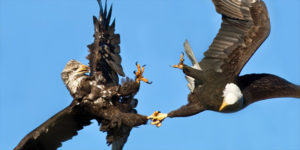
For those experienced birders and frequent Refuge visitors, late winter through the early summer is an exciting time on the Refuge for a variety of reasons. Of course, as spring comes around, things are in bloom, but more importantly, it’s breeding season for many species of bird and mammal on the Refuge.
Raptors, in particular, have been putting on mating displays, building nests, and defending territory. Bald Eagles have been spotted bringing nesting material to their nest to the north of the Refuge’s office. There has been a breeding pair living in that tall bunch of fir trees viewed from the office for a few years now, an exciting annual milestone to look forward to. Their breeding season begins in November or December, after which they build the nest, and begin to lay the eggs as early as mid-February.
Bald Eagles are abundant in our Refuge if you know what to look for. Juvenile and sub-adult Bald Eagles don’t come into their full white head and tail for up to five years, meaning that they look very different from their adult parents for a lot longer than you would expect.

Juvenile and sub-adult Bald Eagles are brown all over and mottled to varying degrees. Their beaks start out dark and become the signature yellow of an adult Eagle, and they only start to really resemble adults in their fourth year. Often mistaken for Golden Eagles, which are rare here in Ridgefield, we get an influx of these seemingly huge eagles in the wintertime, especially when the leaves are off the trees so they are easier to spot- their patterning making them harder to see when the branches are full. To me at least, they seem so much larger than their parents, though I know this can’t be possible. These young ones don’t begin their own nesting practices until they enter their late 3rd or 4th year.

You’ll find Bald Eagles soaring high in the sky, flapping low over treetops with slow wingbeats, or perched in trees or on the ground. This is as opposed to Turkey Vultures, who can be mistaken for eagles at high altitudes. Turkey Vultures soar and tip their whole body without much wing flapping.
Bald Eagles scavenge many meals by harassing other birds or by eating carrion or garbage. They eat mainly fish, but also hunt mammals, gulls, and waterfowl. Coots are a favorite of theirs on the Refuge.
The Bald Eagle’s recovery is a spectacular conservation success story, with numbers increases between 1966 and 2015, according to the North American Breeding Bird Survey. Partners in Flight estimates the global breeding population at 250,000, with 88 percent spending some part of the year in the U.S., 31 percent in Canada, and 8 percent in Mexico.
Once abundant in North America, the species became rare in the mid-to-late 1900s—the victim of trapping, shooting, and poisoning as well as pesticide-caused reproductive failures. In 1978 the bird was listed for protection under the Endangered Species Act. Since 1980, gentler treatment by humans along with the banning of DDT (the bird’s main pesticide threat) have led to a dramatic resurgence. By the late 1990s, breeding populations of Bald Eagles could be found throughout most of North America. In June 2007, the bird’s recovery prompted its removal from the Endangered Species list. Continuing threats to Bald Eagle populations include lead poisoning from ammunition in hunter-shot prey, collisions with motor vehicles and stationary structures, and development-related destruction of shoreline nesting, perching, roosting and foraging habitats. They are still vulnerable to environmental pollution, as evidenced by the 1989 Exxon Valdez oil spill in Prince William Sound, Alaska. An estimated 247 Bald Eagles died from oil exposure. Population levels in the Sound decreased by almost four percent the following year. The local population returned to pre-spill levels by 1995.
Catch the nesting pair of eagles as they carry large branches to their nest on the Carty Unit

either from the office’s front porch, or looking east from the opening in the trees created by the gate to the train tracks (do not go through gates without permission). From this vantage point, you can see them coming from farther out to the west. Bald Eagles build some of the largest of all bird nests—typically 5 to 6 feet in diameter and 2 to 4 feet tall, and ranging in shape from cylindrical to conical to flat, depending on the supporting tree. Both sexes bring materials to the nest, but the female does most of the placement. They weave together sticks and fill in the cracks with softer material such as grass, moss, or cornstalks. The inside of the nest is lined first with lichen or other fine woody material, then with downy feathers and sometimes sprigs of greenery. Nests can take up to three months to build, and may be reused (and added to) year after year.
Hopefully this year we will hear some squawking and peeping of babies in the next month or so, Bald Eagles can lay up to two eggs.
Did you know? Another reason Bald Eagles are being spotted in higher numbers is that the smelt are running right now, meaning that in the local rivers, smelt (a type of fish) are going upstream to mate and die. The number of them are high in the water before and after mating, attracting all the marine inclined birds and scavengers.
-Samantha Zeiner
Friends of RNWR Administrative Coordinator